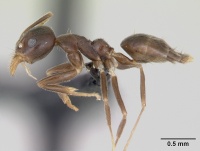Technomyrmex gorgona
| Technomyrmex gorgona | |
|---|---|

| |
| Scientific classification | |
| Kingdom: | Animalia |
| Phylum: | Arthropoda |
| Class: | Insecta |
| Order: | Hymenoptera |
| Family: | Formicidae |
| Subfamily: | Dolichoderinae |
| Genus: | Technomyrmex |
| Species: | T. gorgona |
| Binomial name | |
| Technomyrmex gorgona Fernández & Guerrero, 2008 | |
This is the second extant species of Technomyrmex native to the New World. It is only known from Gorgona National Park, Cauca, Colombia, a small continental Island in the Pacific Ocean. (Fernández and Guerrero 2008)
Identification
Fernández and Guerrero (2008) - Its dark brown color, heavy fine punctuation on the mesonotum and dorsum of propodeum distinguishes it from the only other native congener Technomyrmex fulvus (a number of introduced species occur in the New World but are not presently known from Columbia).
Keys including this Species
Distribution
Latitudinal Distribution Pattern
Latitudinal Range: 2.966666667° to 2.966666667°.
| North Temperate |
North Subtropical |
Tropical | South Subtropical |
South Temperate |
- Source: AntMaps
Distribution based on Regional Taxon Lists
Neotropical Region: Colombia (type locality).
Distribution based on AntMaps
Distribution based on AntWeb specimens
Check data from AntWeb
Countries Occupied
| Number of countries occupied by this species based on AntWiki Regional Taxon Lists. In general, fewer countries occupied indicates a narrower range, while more countries indicates a more widespread species. |

|
Estimated Abundance
| Relative abundance based on number of AntMaps records per species (this species within the purple bar). Fewer records (to the left) indicates a less abundant/encountered species while more records (to the right) indicates more abundant/encountered species. |

|
Biology
Castes
Images from AntWeb

| |
| Paratype of Technomyrmex gorgona. Worker. Specimen code casent0173586. Photographer April Nobile, uploaded by California Academy of Sciences. | Owned by CAS, San Francisco, CA, USA. |
Nomenclature
The following information is derived from Barry Bolton's Online Catalogue of the Ants of the World.
- gorgona. Technomyrmex gorgona Fernández & Guerrero, 2008: 111, fig. 3 (w.) COLOMBIA.
Unless otherwise noted the text for the remainder of this section is reported from the publication that includes the original description.
Description
Worker
Holotype (Paratypes, N= 2): TL 3.17 (3.27 – 3.32), HL 0.69 (0.66 – 0.67), HW 0.68 (0.65 – 0.66), SL 0.72 (0.71), PW 0.46 (0.45 – 0.46), WL 0.95 (0.97 – 0.99), CI 99 (98 – 99), SI 104 (106 – 108), OI 32 (36), EPI 56 (55 – 56), DTI 125 (124 – 127).
Head in full-face view with the posterior margin feebly concave in the middle. Outer margin of eye very close to the side of the head. Anterior clypeal margin with median concavity. Mesonotum in profile shallowly convex anteriorly and with a steeply sloping declivitous face that extends down to the tuberculiform metathoracic spiracle. Propodeal dorsum convex in profile; dorsum rounded evenly into declivity. Body smooth and shining, except for a fine reticulation in the posterior half of pronotum, dense and fine punctuation on the dorsum and sides (mesopleuron) of mesonotum and dorsum of propodeum. Head dorsum in profile entirely lacks setae behind the level of the posterior margin of the eye; dorsum of head with numerous very short spaced erect and suberect setae (less than 0.50 × the maximum diameter of the eye), numerous suberect (0.03 mm) setae between the torulus and the level of the midlength of the eye, anterior clypeus with four hairs, about 0.13 mm each long; pronotum with 2 pairs of long setae, arising from very wellmarked pits; Gastral tergites 1 - 4 each with 2 – 4 very long erect setae. Short pubescence on scapes and dorsal (outer) surfaces of middle and hind tibiae usually almost appressed, but slightly elevated in some. Body dark brown. Head and body brown, scape apex, flagellomeres and mandibles lighter.
Type Material
Holotype worker: COLOMBIA. Cauca. Gorgona Island National Park. 02°58’N 78°11’W. 180 m. 01-mar-04-abr-2000. Sharkey, M. Humboldt Institute. Paratype workers (2 workers): Same data, deposited in Insect Collection, Instituto de Ciencias Naturales, California Academy of Sciences.
Etymology
The name gorgona refers to the Gorgona National Park, and is given as a noun in apposition.
References
- Fernández, F. and R. J. Guerrero. 2008. Technomyrmex (Formicidae: Dolichoderinae) in the New World: synopsis and description of a new species. Revista Colombiana de Entomología. 34:110-115.
- Perrichot, V., Boudinot, B.E., Engel, M.S., Xu, C., Bojarski, B., Szwedo, J. 2022. Ants (Hymenoptera: Formicidae) from Miocene Ethiopian amber: filling gaps in the geological record of African terrestrial biota, Zoological Journal of the Linnean Society, 2022, zlac053 (doi:10.1093/zoolinnean/zlac053).

